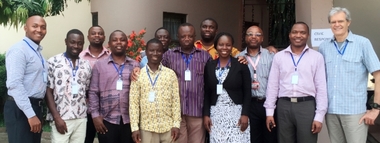- Home
- Accra meeting discusses closer HDSS, CRVS linkages
Accra meeting discusses closer HDSS, CRVS linkages
Scientists from Tanzania and Ghana shared experiences as they discussed opportunities and approaches for Integrating Mortality Surveillance Systems.
This happened during a workshop held in Accra from 24-26 May 2016 under the INDEPTH and Bloomberg Data for Health Initiative. Twelve participants from Switzerland, Tanzania and Ghana took part in the workshop.
The workshop focused on facilitating formal linkages between CRVS and HDSS leadership in selected countries where these co-exist.
It was also aimed at developing joint protocols for data sharing and linkage that would allow assessment of basic birth and death coverage or completeness for conducting comparative assessment of cause specific mortality fractions and for facilitating formal birth and death "registration" functions for events captured in HDSS or SAVVY sites.
The rationale behind the initiative is to design and test approaches to engineer effective, continuous collaboration, technical exchange and data sharing between longitudinal Health and Demographic Surveillance Systems (HDSS) or sentinel registration systems (SAVVY) sites and routine Civil Registration of Vital Statistics (CRVS) systems.
For many years HDSS or SAVVY sites have monitored pregnancies, births, deaths, and causes of death through verbal autopsy (VA). However, HDSS sites have never been harnessed as routine technical partners in CRVS in any of the countries where they operate.
"This is a huge missed opportunity for both the CRVS systems and the HDSS sites that can be relatively quickly addressed. It is ironic that two data intensive enterprises, CRVS and HDSS, that measure the same births, deaths and causes of death in the same countries, never collaborate," said Prof. Don de Savigny from Swiss TPH who is the anchor of the Innovations Component of the Bloomberg Data for Health Initiative, who facilitated at the workshop.
HDSS expertise and data remains in its own national silo and is not seen as an integral part of the fabric of national health information systems or CRVS systems.
Connecting demographic and analytic expertise between the HDSS/SAVVY and CRVS communities will be mutually supportive and should lead to greater confidence in CRVS data and its eventual use.
In what he described as a "paradox of enterprises" he said CRVS, SAVVY and HDSS have been trying to achieve the same objective, "but we have not been sharing skills, data, information and experience."
"It is crazy the way these systems are fragmented...keep information in their silos. We have to try and break the silos- bring together HDSS people, SAVVY statistics people."
He said the leadership of the INDEPTH Network had shown commitment to redress this situation and is looking for initiatives and methodologies to re-engineer relationships.
"Osman (INDEPTH Network ED) even published a paper on how we can come together," he said.
Some other observations during the workshop included the involvement of multiple institutions and actors in CRVS and sometimes lack of coordination and governance which pose a key challenge in building effective CRVS Information System.
CRVS is multi-sectoral, a variety of actors are involved in the recording, notification and registering of vital events (citizens, health-care workers, doctors, police officers, clerics, and ministries of health, justice and home affairs, for example) and the use of its outputs (such as health authorities, tax authorities and policy-makers).
The other observation was that the success of civil registration depends upon the willingness of individuals and families to register vital events. No matter how good the laws in place are, they cannot guarantee public participation. Collaboration with civil society organisations can help to promote awareness of the benefits of registration, and foster public trust in the system.
There were also observations and how traditional channels through traditional leaders and community Key Informers could be strengthened and contribute to the flow of vital information.
The INDEPTH Executive Director said during the workshop that this was the way the Network saw its future: "We have always felt that we need to do more than what we currently do in areas in order to contribute more to the countries where we operate."
In the relation to this, he mentioned INDEPTH’s contribution to CVRS strengthening in Africa and the Comprehensive Health and Epidemiological Surveillance System (CHESS).

